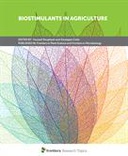Explore

Biostimulants in Agriculture
0 Ungluers have
Faved this Work
Login to Fave
In the coming few years, agriculture must meet the twin challenge of feeding a growing global population, while simultaneously minimizing the environmental impact of cropping systems. In other words, new farming practices should be introduced in order to produce more food in a sustainable way. One of the most promising and innovative technologies to tackle these rising challenges consists in the use of plant biostimulants which include substances and/or micro-organisms, other than fertilizers and pesticides, able to promote plant growth, yield and to improve produce quality as well as resource use efficiency when applied to the crop in low quantities. Beneficial substances such as humic and fulvic acids, protein hydrolysates, seaweed and plant extracts, as well as beneficial microorganisms such as Azotobacter, Azospirillum, Rhizobium and arbuscular mycorrhizal fungi have been shown to play multiple roles as biostimulants through the regulation and/or modification of the primary and secondary metabolism in plants, to enhance productivity, and to improve plant resilience to environmental perturbations. The biostimulant effects of these natural substances and microorganisms have been mainly associated to direct (stimulation of enzyme activities and hormonal activities) and also indirect (modification of natural microbial community, improvement of soil nutrient availability) effects on plant. However, the detailed molecular, cellular and physiological mechanisms underlying plant-biostimulant interactions under different environment and management strategies remain largely unknown. Therefore, there is an urgent need among the scientific community and commercial enterprises to better elucidate the causal/functional mechanism of biostimulants. The elucidation of the agricultural function and action mechanisms of plant biostimulants will permit to develop a second generation of biostimulants where synergies and complementary mechanism can be functionally designed. This Research Topic welcome Original Research, Technology Report, Methods, Opinion and Perspectives dissecting the agricultural functions and action mechanisms of plant biostimulants under adverse environmental situations (e.g., salinity, drought, thermal stress, suboptimal pH values, heavy metals, nutrient stress) or in optimum growing conditions.
This book is included in DOAB.
Why read this book? Have your say.
You must be logged in to comment.
Rights Information
Are you the author or publisher of this work? If so, you can claim it as yours by registering as an Unglue.it rights holder.Downloads
This work has been downloaded 171 times via unglue.it ebook links.
- 101 - epub (CC BY) at Unglue.it.
- 70 - pdf (CC BY) at Unglue.it.
Keywords
- Biology, Life Sciences
- Botany & plant sciences
- high-throughput phenotyping
- humic acids
- Mathematics & science
- Mycorrhizal fungi
- nutrient use efficiency
- physiological and molecular mechanisms
- plant growth promoting rhizobacteria
- protein hydrolysates
- Science: general issues
- seaweed extracts
- thema EDItEUR::P Mathematics and Science::PD Science: general issues
- thema EDItEUR::P Mathematics and Science::PS Biology, life sciences::PST Botany and plant sciences
Links
DOI: 10.3389/978-2-88963-558-0Editions

